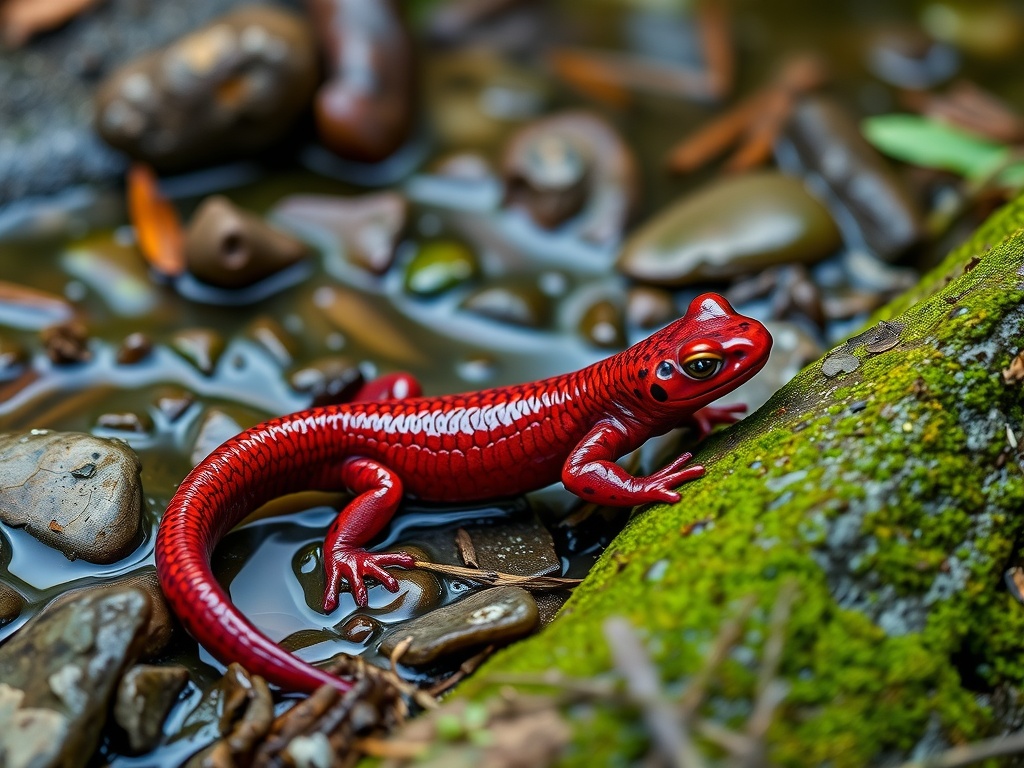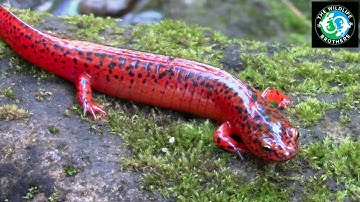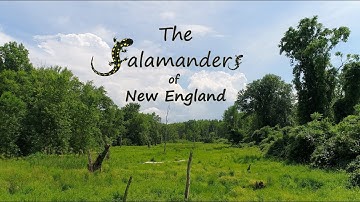
Red Salamander
Pseudotriton ruber

Meet the Red Salamander
The Red Salamander is a striking amphibian known for its bright red or orange coloration, often speckled with black spots. This medium-sized salamander is primarily found in the eastern United States, inhabiting moist forests near clear, cold streams, springs, and seepages. Red Salamanders are secretive, spending much of their time under rocks, logs, or leaf litter, especially during the day. They are important predators of invertebrates in their ecosystems and are often considered indicators of clean water quality due to their sensitivity to pollution.
Classification
Amphibian
Habitat
Moist forests near streams and springs
Diet
Carnivore
Lifespan
10-20 years
Conservation
Least Concern
Weight
5-12 grams
📖Fascinating Facts
Bright Coloration
The Red Salamander's red-to-orange skin with black spots makes it one of the most colorful North American salamanders.
Clean Water Indicator
Red Salamanders are highly sensitive to pollution, making their presence an indicator of clean, unpolluted streams and springs.
Terrestrial Lifestyle
While their larvae are aquatic, adult Red Salamanders spend most of their lives on land but never far from moist environments.
📋Detailed Description
The Red Salamander (Pseudotriton ruber) is a robust, medium- to large-sized plethodontid salamander, typically measuring 11–18 cm (4.3–7.1 in) in total length, with some individuals reaching up to 20 cm. Its skin is smooth and moist, displaying vivid red, orange, or reddish-brown coloration heavily marked with irregular black spots; juveniles are often brighter and become duller with age. The head is broad and somewhat flattened, with prominent, golden to yellow eyes lacking a distinct black crossbar—a feature distinguishing it from similar species. As a lungless salamander, P. ruber relies entirely on cutaneous and buccopharyngeal respiration, requiring consistently moist environments. The tail is laterally compressed and muscular, aiding in swimming. Red Salamanders are primarily nocturnal, spending daylight hours concealed under rocks, logs, or leaf litter, emerging at night or during wet weather to forage. They are solitary outside of the breeding season and exhibit strong site fidelity, often returning to the same microhabitats. Their diet is diverse, consisting mainly of aquatic and terrestrial invertebrates, but also includes small vertebrates such as other salamanders. This species is semiaquatic throughout life: larvae are fully aquatic, while adults maintain close ties to water sources. Red Salamanders are long-lived, with lifespans in the wild estimated at 10–20 years. Their bright coloration is thought to be aposematic, mimicking the toxic Eastern Newt (Notophthalmus viridescens) and deterring predators.
💡 Did you know?
Despite their bright color, Red Salamanders are not actually toxic, but their appearance helps them avoid predation through mimicry.
🔬Research & Sources
Wikipedia Summary
The red salamander is a species of salamander in the family (Plethodontidae) endemic to the eastern United States. Its skin is brown, orange or red with random black spots. Semiaquatic adults and aquatic larvae live in temperate forests, small creeks, bogs, ponds, intermittent streams, and freshwater springs. Overall this species is common and widespread, but locally it has declined because of habitat loss and it is considered threatened in Indiana and New York. Red salamanders eat insects, earthworms, spiders, small crustaceans, snails, and smaller salamanders. To eat, they extend their tongue to capture prey on the tip of it and retract it back into their mouths. The red salamander, as a member of the family Plethodontidae lacks lungs and respires through its skin.
Last Modified: 5/25/2025
🎭Behavior & Social Structure
Red Salamanders are secretive and primarily nocturnal, with peak activity occurring on rainy or humid nights. They are ambush predators, remaining motionless and using their projectile tongue to capture prey with remarkable speed and accuracy. Their diet includes insects (especially aquatic larvae), earthworms, spiders, snails, small crustaceans, and occasionally other salamanders, including conspecifics. Adults exhibit territoriality, particularly in high-quality microhabitats, and may display aggressive behaviors such as biting or posturing when threatened by conspecifics. They are generally solitary, except during the breeding season, and do not form social groups. Daily routines involve remaining hidden during the day to avoid desiccation and predation, with foraging and movement primarily at night or during wet weather. Larvae are aquatic and benthic, feeding on small aquatic invertebrates and detritus.
👶Reproduction & Life Cycle
Breeding occurs primarily in late autumn through early spring (October–April), varying by latitude and elevation. Courtship takes place in or near streams, where males deposit spermatophores on the substrate. Females pick up the spermatophore with their cloaca, resulting in internal fertilization. Females lay 30–130 eggs in clusters attached to the undersides of submerged rocks or debris in cool, clean streams or springs. Incubation lasts 2–3 months, depending on water temperature. Larvae are fully aquatic and undergo a prolonged larval period of 2–3 years before metamorphosis, which is influenced by environmental conditions such as water temperature and food availability. There is no parental care after egg deposition; however, females may remain near the nest site for a short period post-laying.
🛡️Adaptations & Survival
Pseudotriton ruber exhibits several adaptations for its semiaquatic lifestyle. Its lungless physiology allows for efficient gas exchange through moist skin and mouth lining, but restricts it to humid, well-oxygenated environments. The bright red coloration serves as Batesian mimicry of the toxic Eastern Newt, reducing predation risk. Its laterally compressed tail and webbed digits enhance swimming ability. The highly protrusible tongue is specialized for rapid prey capture. Larvae possess external gills for aquatic respiration and cryptic coloration for camouflage. Adults have a strong homing instinct, enabling them to navigate back to preferred microhabitats. Their tolerance for cold water allows them to remain active in cooler months when many predators are less active.
🎨Cultural Significance
The Red Salamander has limited direct cultural significance but is occasionally featured in regional folklore as a symbol of clean water and healthy forests. Its striking appearance has made it a subject of interest among naturalists and herpetologists. In some Native American traditions, salamanders in general are associated with water and transformation. The species is also used as an environmental indicator in ecological studies due to its sensitivity to pollution and habitat disturbance, underscoring its importance in conservation education and outreach.
🔬Recent Research & Discoveries
Recent research on Pseudotriton ruber has focused on its role as a bioindicator of stream health, with studies demonstrating strong correlations between salamander abundance and water quality parameters. Genetic studies have revealed significant population structure across its range, suggesting limited dispersal and highlighting the importance of maintaining habitat connectivity. Investigations into its mimicry of the Eastern Newt have provided insights into predator-prey dynamics and the evolution of aposematism in amphibians. Ongoing research is examining the impacts of climate change on larval development and stream hydrology, as well as the effects of emerging pathogens such as Batrachochytrium salamandrivorans (Bsal) on population viability.
🎥Wildlife Videos

Fire Salamander - The Last Urban Dragon | Free Documentary Nature
Fire Salamander - The Last Urban Dragon | Free Documentary Nature Watch 'Fire Salamander - Spectacular Footage of the ...
Free Documentary - Nature

A very RARE and very RED Salamander!
We have spent the vast majority of our lives herping the woodlands and creeks of Eastern Pennsylvania, and we are pretty well ...
The Wildlife Brothers

LEGENDS OF THE RED DUST | Tsavo’s Predators Unleashed #naturedocumentaries | Wild Nature
LEGENDS OF THE RED DUST | Tsavo's Predators Unleashed #naturedocumentaries | Wild Nature Welcome to a wild and ...
WILD NATURE - Nature animal documentary

The Salamanders of New England
Salamanders are plentiful in many forests, but due to their underground (or underwater) lifestyles, for the most part are not often ...
New England Forests

The Red Salamander and warning coloration: Mullerian Mimicry
I share my discovery of this Red Salamander that I found right in my backyard! Close-up footage and the meaning of its unique ...
Nature at Your Door Frank Taylor

Into the Forest: Amphibian Nature Documentary
The Fire Salamander and its plight with Bsal are featured. Bsal is a microscopic fungus that was accidentally imported into Europe ...
Bryan Maltais
🌍Habitat Information
The Red Salamander typically inhabits Moist forests near streams and springs environments. Red Salamanders have adapted to their environments with specialized features and behaviors.
Primary Habitat:
Moist forests near streams and springs
More detailed habitat information will be available soon.
🛡️Conservation Status
The Red Salamander is currently classified as Least Concern. Conservation efforts are crucial for preserving this species for future generations.
Common Threats:
- 🏠Habitat loss and fragmentation
- 🌡️Climate change impacts
- 🎯Hunting and poaching
- 🏭Human-wildlife conflict
⚠️Threats & Conservation Challenges
While the Red Salamander is currently listed as Least Concern by the IUCN, populations face localized declines due to habitat loss, fragmentation, and degradation, especially from deforestation, urbanization, and water pollution. Stream siltation, acidification, and chemical runoff (e.g., pesticides, road salts) negatively impact both larvae and adults, which are highly sensitive to changes in water quality. Road mortality during seasonal migrations and collection for the pet trade are additional threats in some areas. Climate change poses emerging risks by altering hydrological regimes and increasing the frequency of droughts. The species is considered threatened or of special concern in several states, including Indiana and New York, where habitat protection and water quality management are conservation priorities.
🔬Scientific Classification
Scientific Name
Pseudotriton ruber
Classification Hierarchy
🔍 About Taxonomic Classification
Taxonomic classification is a hierarchical system used by scientists to classify and organize living organisms based on shared characteristics and evolutionary relationships.
The system moves from broad categories (Kingdom) to increasingly specific ones, with each animal's scientific name typically consisting of its Genus and species.
📝Community Notes
Share your observations and insights about the Red Salamander with our community of wildlife enthusiasts.
Join Our Community
Sign in to share your observations and connect with fellow wildlife enthusiasts.
Sign In to ContributeNo community notes yet
Be the first to share your observations about the Red Salamander!
Explore Red Salamander
Select a tab above to learn more about this amazing animal.
📸Photo Gallery
No photos available for this animal yet.
🌟Discover More Wildlife
Continue your journey of discovery with more fascinating animals from our database
